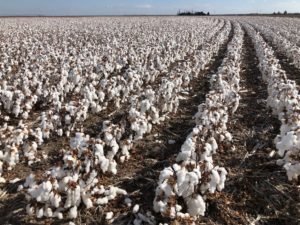Cotton prices rebound, but supplies high
Texas Crop and Weather Report – Nov. 10, 2020
Cotton prices recently bounced back following a steady fall driven by the pandemic’s effect on U.S. and global demand, according to a Texas A&M AgriLife Extension Service expert.

John Robinson, Ph.D., AgriLife Extension cotton economist, Bryan-College Station, said the latest U.S. Department of Agriculture cotton estimate report, however, likely means prices won’t continue to climb.
Robinson said cotton prices were responding well to the November 2019 Phase 1 trade agreement with China when COVID-19 began wreaking havoc on global markets in February.
COVID-19’s effect on cotton was pretty dramatic, Robinson said. Cotton futures fell more than 20 cents, from 70 cents per pound to 49 cents per pound, from February to April.
“That’s just the fears and uncertainty of pandemic, recessionary fears, because cotton demand always goes down in a recession,” he said. “Cotton represents discretionary spending on wardrobe purchases, but the pandemic added another wrinkle when you had stores physically closed by the shutdowns.”
Textile mill shutdowns in China also made a big impact on the price drop, he said.
In April, the Chinese government began strategically buying bales to add to or replenish their cotton reserves, Robinson said. Chinese reserve buying helped trigger a steady upward price march over the summer.
Robinson said Mother Nature was not ideal for the U.S. cotton crop this year. Drought in West and South Texas followed by multiple tropical storms that struck with varying severity from Texas to Georgia brought into question the projected U.S. crop size.
Tropical storms along the coast were followed by freezing temperatures, sleet and rains in the Texas Plains and Panhandle as harvest got underway, he said.
“It was a tough production year, and there were a lot of questions about yields and quality,” he said.
The bad weather also triggered price speculator buying, which helped cotton’s march back to 70 cents per pound as of Nov. 10, Robinson said.
Crop estimate remains static
Robinson expected U.S. yield estimates could drop as much as 600,000 bales based on weather events throughout cotton-producing states. But the Nov. 11 USDA report maintained the previous estimates of 17 million bales.
Quality could be an issue with this year’s cotton crop due to the storms, he said.
“I suspect this report means there is a lot of low-grade cotton out there and that there will be an oversupply of low-quality cotton,” he said. “You’ve got reports of wind damage, stringing, discoloration, boll rot, but it looks like a lot of acres are being counted rather than marked as a loss.”
Robinson said the projection likely means a 7.2 million-bale surplus carryover from 2020, which translates into high supplies and bearish cotton prices for the foreseeable future. The estimated surplus is the highest since 2007-2008, according to the USDA report.
The election may affect trade but the bigger question for cotton will be U.S. economic recovery, Robinson said. Distribution of an effective COVID vaccination could expedite that recovery.
“To have the November report show no change, that tells me they may be counting bolls and acres that are out there and are not predicting a cut,” he said. “These reports get closer and closer to the real number the later it gets in the season, so this report reinforces the thought that we’ll have heavy supplies and prices aren’t likely to improve much for Texas producers. And even if there is a major production cut late in the year, it still might leave 6.5 million bales of ending stocks, which is not price supportive.”
AgriLife Extension district reporters compiled the following summaries:
CENTRAL
More than half of counties reported short soil moisture. The second crop of corn silage was being harvested. Most all peanuts and cotton were harvested. Pecan harvest was underway. There were still a few small grains fields to be planted, but most seed were in the ground and had germinated. Recent moisture and cooler temperatures drastically improved small grains conditions. Winter grasses were also improving. Cattle markets were down, and some producers were planning to hold cattle through the winter in hopes of a price turnaround. Topsoil remained “powder dry” in some areas and winter forage planting remained stalled. The planting window was shrinking for those fields, and dry seeding was not an option due to various potential problems. Producers in drier areas were reporting extremely low to completely dry stock tanks, something not seen for a very long time. Pastures were being grazed down. Cooler night temperatures with each passing cold front over the past couple of weeks is starting to trigger Bermuda grass to go into dormancy.
ROLLING PLAINS
Weather conditions were warm to mild. Recent rainfall was beneficial to wheat. Some wheat pastures were in good condition and ready for grazing. Damages from the October freeze were minimal to later-planted cotton. Cotton was being harvested.
COASTAL BEND
Conditions continued to be dry and warm. Soil moisture levels were reaching critical levels, especially for producers who planted oat, wheat and ryegrass winter pastures. Producers were getting equipment ready for fertilization. Ratoon rice crop harvest continued. Some hay was still being cut and baled. Some livestock were being supplemented with hay and protein. Large runs of livestock were still being seen at local auctions due to weaning and culling, but prices were steady. Cattle were in fair to good condition. Pecan harvest continued with good yields reported.
EAST
The district needed rainfall. A few areas, like Cherokee and Jasper counties, were reporting good soil moisture levels. Warm-season forage growth slowed. Sabine County producers continued hay harvesting. Cattle market prices were higher than last week. Livestock were in fair to good condition. Wild pig activity continued, causing damage to hay meadows and pastures.
SOUTH PLAINS
Fields dried out quickly after the snow and ice storm last week. Farmers were able to get back into fields Monday. Cotton harvest resumed, and some producers were planting winter wheat. Many producers were not planting winter wheat due to the lack of moisture. Cotton gins expected to wrap up operations by early December. Cattle were requiring supplemental feed amid poor pasture conditions.
PANHANDLE
Northern and central parts of the district reported short to adequate topsoil and subsoil moisture. Southern areas reported very short to short soil moisture levels. Sorghum was being harvested. Cotton conditions were poor to fair. Winter wheat was good to fair in areas with better moisture and poor to fair in drier areas. Warmer, drier weather allowed harvest activities in corn, cotton and grain sorghum to resume. Yields were below average this year due to extremely dry conditions throughout the summer. Recently planted wheat stands were excellent due to recent moisture, but the region remained very dry.
NORTH
Topsoil moisture throughout the district was adequate to short. Sporadic rain was reported, and temperatures went up and down. More rain was needed. Feral hogs were very active. Winter wheat planting was wrapping up as early planted wheat emerged. Livestock were in great condition with an abundance of available forage. Spring-born calves were being weaned and looking good.
FAR WEST
Temperature highs were in the upper 80s with lows in the upper 30s. No precipitation was reported. Cotton harvest neared completion. Many cotton producers plowed up their stands. Many irrigated fields were producing poor cotton. Yields continued to be well below average with no dryland acres harvested. However, grades were decent considering the year. Wheat plantings continued to be on hold as producers waited for rain. Dry plantings could begin soon. Alfalfa growers were making a last cutting. Pumpkin picking continued, and corn was still maturing. Pastures were bare, and most cattle were sold or moved to pastures with grass. Pecans were beginning to drop, and yields were down significantly. Producers continue to feed livestock and wildlife. Deer hunters were arriving as hunting season opened.
WEST CENTRAL
Weather was relatively warm. Winter wheat was in mostly good condition, and planting continued. Cotton harvest resumed following the ice storm. The ice storm caused some crop loss, and some fields were not expected to be harvested. Rangelands and pastures were in fair condition. Some cool-season grasses emerged. Livestock were in fair condition. Supplemental feeding continued.
SOUTHEAST
Dry conditions continued, and moisture was needed. Established small grain forages were holding up surprisingly well. Some winter wheat was planted in Jefferson County and received a significant amount of rain. Producers were unsure how it might recover, but it should be OK if the area avoids rain long enough to dry some. Soil moisture levels ranged from adequate to very short with adequate levels being the most common.
SOUTHWEST
Moisture conditions continued to decline across the district with little to no rain reported. Rangeland and pasture conditions were declining. Some winter wheat planting was postponed until rainfall arrived. Livestock conditions were fair to good as supplemental feeding continued.
SOUTH
Soil moisture conditions in northern, western and eastern parts of the district were short to very short and adequate in southern areas. Weather conditions were hot to mild and dry. Peanut harvesting was well underway. Wheat planting continued and should be complete soon in areas with moisture but remained stalled in drier areas. Some late Bermuda hay cutting and baling continued. Livestock supplemental feeding continued to increase, and rangeland and pasture conditions declined due to dry conditions. A heavy dew in McMullen County helped maintain rangeland conditions. Cattle prices were steady. Stock tanks were declining in some areas and full in others. Deer season was in full swing with an increase of hunters entering the district. Trees were defoliating. Vegetables looked good, and citrus was being harvested. Some vegetable crop harvests ended, and farmers were preparing the soil for next season. Producers continued to bale buffelgrass and harvest seed. Sesame harvest ended. There was some fall-planted corn in the central Rio Grande Valley.





